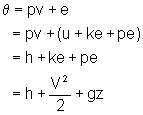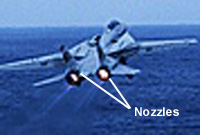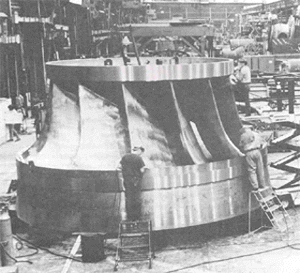![]()
![]()
![]()
For closed systems, the conservation of mass principle is implicitly used by requiring that the mass of the system remain constant during a process.
In fluid mechanics, conservation of mass : continuity equation.
Mass and Volumetric Flow Rates
![]()
![]()
![]() (
(![]() V:
mass flux mass flow rate/unit area)
V:
mass flux mass flow rate/unit area)
![]()
![]()
One-Dimensional Flows
1. Flow is normal to the boundaries at locations where mass enters or exits the CV.
2. All intensive properties (including velocity) are uniform with position.
![]()
![]() where AV= volumetric flow rate
where AV= volumetric flow rate
![]()
![]()
Equality of total incoming and outgoing rates of mass flow does not necessarily mean that a control volume is at steady state since other properties such as temperature and pressure might be varying with time.
Closed Systems:
![]()
Control Volumes:

Flow Work
Unlike closed systems, control volumes involve mass flow cross their boundary, and some work is required to push the mass into or out of the control volume. This work is known as the flow work, or flow energy, and is necessary for maintaining a continuous flow through a control volume.
Consider a fluid element of volume V as shown in the figure. The fluid immediately upstream will force this fluid element to enter the control volume; thus it can be regarded as an imaginary piston. If the fluid pressure is p and the cross-sectional area of the fluid element is A, the force applied on the fluid element (by the imaginary piston) is
F = pA
The work done in pushing the fluid element across the boundary is
![]()
The flow work relation is the same whether the fluid element is pushed into or out of the control volume.
The total energy of a flowing fluid on a unit-mass basis becomes

By using the enthalpy instead of the internal energy to represent the energy of a flowing fluid, one does not need to be concerned about the flow work. The energy associated with pushing the fluid into or out of the control volume is automatically taken care of by enthalpy. In fact, this is the main reason for defining the property enthalpy.

A process during which a fluid flows through a control volume steadily.
The fluid properties can change from point to point within the control volume, but at any fixed point they remain the same during the entire process.
1. No properties (intensive or extensive) within the control volume change with time.
![]() =constant,
=constant,
![]() constant
constant
2. No properties change at the boundaries of the control volume with time.
Thus, the fluid properties at an inlet or an exit will remain the same during the entire process. The properties may, however, be different at different openings.
3. The heat and work interactions between a steady-flow system and its surroundings do not change with time.
Although some devices operate in a periodic manner, the flow through these devices can still be analyzed as a steady-flow process by using time-averaged values for the properties and the heat flow rates through the boundaries.
|
Conservation
of Mass
|
|
Conservation
of Energy
|
 |
|
For
Single-Stream Steady-Flow Process
|
 |
|
Nozzles
and Diffusers
|
||||
|
A nozzle
is a device used to accelerate the velocity of a gas or liquid in
the direction of flow while a diffuser is used to decelerate the
flow.
The cross-sectional area of a nozzle decreases in the direction of flow and it increases for a diffuser. For nozzles and diffusers, the only work is flow work. |
 Nozzles of a Tomcat Fighter |
|||
|
Conservation
of Mass
|
||||
|
Conservation
of Energy |
|
|||
| Turbine
is a device in which work is developed as a result of the expansion
of a gas or superheated steam through a set of blades attached to
a shaft free to rotate. (Reference: B. R., Munson, D. F. Young, and T. H. Okiishi, Fundamentals of Fluid Mechanics, 2nd Ed., John Wiley & Sons, Inc., New York, 1994.) |
 |
|
Devices in which work is done
to raise the pressure of a gas/liquid.
 ,
or
,
or